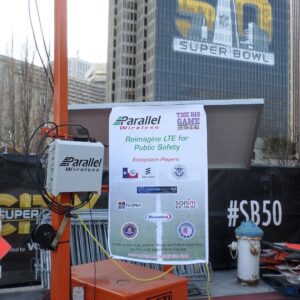FirstNet’s LTE network for public safety is getting some early use at major sporting events, with small-scale temporary deployments that are giving first responders a taste of what it’s like to have their own cellular network amid heavy traffic on commercial carriers.
At Super Bowl 50, a small group of vendors came together to rapidly deploy a Band 14 LTE network to

support about three dozen devices plus a sensor network for video feeds. Rajesh Mishra, co-founder and CTO of Parallel Wireless, said that the installation utilized FirstNet resources remotely: Sonim devices were on the ground along with nodes installed in California, an interop system from MutuaLink to tie in Land Mobile Radio, and bridged to the EPC of FirstNet early builder Harris County, Tex. using Parallel’s bridging hetnet gateway based in New Hampshire.
Mishra said that Parallel was contacted about the Super Bowl installation less than three weeks before the event, to support users from the Bay Area Regional Interoperable Communications Systems Authority (BayRICS), the Federal Bureau of Investigations, the Department of Homeland Security and other agencies.
An early scenario had called for nodes to be installed on the north and south scoreboards in order to cover the stadium, but ultimately the companies were asked to focus coverage on Super Bowl City, the adjacent outdoor entertainment area for fans. Utilizing fiber backhaul from San Francisco’s municipal fiber network as well as PG&E for two backhaul points, Parallel said those two nodes enabled it to cover the entire Super Bowl City area. Harris County offered access to its EPC, which Parallel had also used to cover a recent FirstNet meeting in Texas. Because the tight deadline didn’t allow for a cell on wheels to be brought it, Parallel relied on its briefcase-sized eNodeBs mounted on 10-foot light towers supplied by the FBI.
Mishra said that as of Monday, Parallel had received a number of positive emails from users on the system on how well it had worked, and that the company was “happy to do our little part.”
Public safety usage stats for the network were not immediately available, but the commercial wireless carriers saw record-breaking, intense usage both leading up to and during the game itself – and the numbers blew away even the heavy usage seen at last year’s Super Bowl.
Verizon said that its customers at Levi’s Stadium used more than 7 terabytes of data on game day, and more than 30 terabytes of data in the days leading up to the Super Bowl — up nearly 270% since last year. Total network use over the nine days leading up to and including game day was 68 terabytes, Verizon reported, or the equivalent of about 45 million social media posts.
AT&T said that its customers used more than 5.2 terabytes of data, reflecting more than 200% growth compared to last year’s Super Bowl. The carrier also added that “mobile traffic from event-related activities taking place Saturday 1/30 through Sunday 2/7 in the Bay Area, including fan fests, concerts, the game and more, totaled more than 28.4 TB,” or more than 81 million social media posts.
Sprint said that its customers used about 1.6 terabytes of data in and around the stadium on game day, and that the distributed antenna system in the stadium saw a 150% increase in use compared to last year’s Super Bowl at University of Phoenix stadium. Traffic around Levi’s Stadium was 93% higher than outside last year’s Super Bowl, and Sprint added that “the biggest spikes in network traffic occurred just after the opening ceremony and immediately following the half time show.”
T-Mobile US reported that its users consumed 2.1 terabytes, with 29% used for social media postings and another 29% for video.

